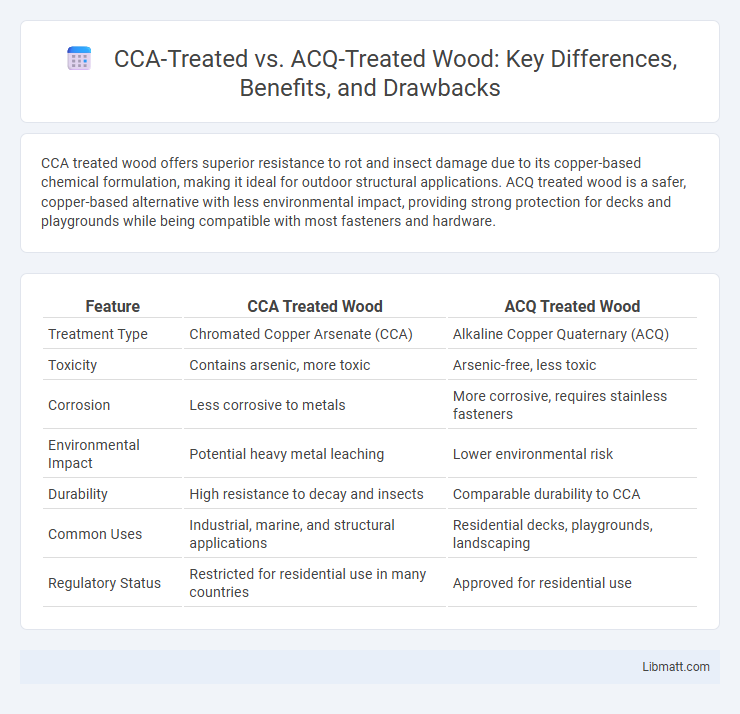CCA treated wood offers superior resistance to rot and insect damage due to its copper-based chemical formulation, making it ideal for outdoor structural applications. ACQ treated wood is a safer, copper-based alternative with less environmental impact, providing strong protection for decks and playgrounds while being compatible with most fasteners and hardware.
Table of Comparison
| Feature | CCA Treated Wood | ACQ Treated Wood |
|---|---|---|
| Treatment Type | Chromated Copper Arsenate (CCA) | Alkaline Copper Quaternary (ACQ) |
| Toxicity | Contains arsenic, more toxic | Arsenic-free, less toxic |
| Corrosion | Less corrosive to metals | More corrosive, requires stainless fasteners |
| Environmental Impact | Potential heavy metal leaching | Lower environmental risk |
| Durability | High resistance to decay and insects | Comparable durability to CCA |
| Common Uses | Industrial, marine, and structural applications | Residential decks, playgrounds, landscaping |
| Regulatory Status | Restricted for residential use in many countries | Approved for residential use |
Introduction to Wood Treatment Methods
CCA treated wood utilizes chromated copper arsenate to protect against rot, decay, and insect damage, making it highly durable for outdoor use. ACQ treated wood employs alkaline copper quaternary compounds, offering a less toxic alternative with comparable resistance to biological threats, suitable for residential and commercial projects. Your choice between CCA and ACQ treatments depends on environmental considerations and the specific application requirements of the treated wood.
Overview of CCA and ACQ Preservatives
CCA (Copper Chromium Arsenate) and ACQ (Alkaline Copper Quaternary) are two widely used wood preservatives designed to protect wood from decay, insects, and fungal damage. CCA contains copper, chromium, and arsenic, providing long-lasting protection but raising environmental and health concerns due to arsenic content, which has led to its restricted use. ACQ, a more environmentally friendly alternative, uses copper combined with a quaternary ammonium compound, offering effective treatment for your wood while minimizing toxic chemical exposure.
Chemical Composition of CCA and ACQ
Chromated Copper Arsenate (CCA) contains a chemical composition primarily of chromium, copper, and arsenic, designed to protect wood from rot, fungi, and insect damage by fixing these elements into the wood fibers. Alkaline Copper Quaternary (ACQ) utilizes copper and quaternary ammonium compounds, with copper providing the main biocidal properties and quaternary ammonium compounds enhancing the treatment against fungi and bacteria. Both treatments rely on copper as a key biocide, but CCA includes arsenic and chromium as preservatives, whereas ACQ relies on safer, arsenic-free compounds for environmental compliance.
Effectiveness Against Decay and Insects
CCA treated wood demonstrates superior effectiveness against decay and insect damage due to its copper-chromium-arsenic formulation, which provides long-lasting protection and resistance in ground contact and high-moisture environments. ACQ treated wood, containing alkaline copper quaternary compounds, offers comparable resistance against fungal decay and insect infestation but tends to have a shorter service life in extreme weather conditions. Both treatments enhance wood durability, yet CCA is generally preferred for heavy-duty applications requiring extended protection against wood rot and termites.
Environmental Impact and Safety Concerns
CCA-treated wood contains chromium, copper, and arsenic, which pose significant environmental risks due to their toxicity and potential to leach into soil and groundwater, raising concerns about groundwater contamination and ecosystem damage. ACQ-treated wood uses alkaline copper quat, which is less toxic and more environmentally friendly, minimizing heavy metal pollution and reducing health hazards during handling and disposal. Choosing ACQ-treated wood enhances your safety and stewardship of the environment by lowering exposure to harmful chemicals and supporting sustainable construction practices.
Health Risks Associated with CCA and ACQ
CCA-treated wood contains chromated copper arsenate, posing significant health risks due to arsenic leaching, which can cause skin irritation, respiratory issues, and long-term exposure risks including cancer. ACQ-treated wood uses alkaline copper quaternary, which reduces toxicity but may still cause skin and eye irritation from copper exposure and respiratory problems during sanding or burning. Proper handling, usage, and disposal of both CCA and ACQ-treated wood are essential to minimize health hazards and environmental contamination.
Cost Comparison: CCA vs ACQ Treated Wood
CCA treated wood generally costs more upfront due to its copper chromium arsenate composition and more complex treatment process, while ACQ treated wood offers a more affordable alternative with comparable durability for many applications. Your choice between CCA and ACQ treated wood should consider long-term value since ACQ may require more frequent maintenance in high-decay environments, affecting overall expenses. Cost efficiency depends on project scale, environmental regulations, and specific usage conditions where each wood treatment excels.
Longevity and Durability of Treated Wood
CCA-treated wood demonstrates superior longevity and durability due to its deep penetration and strong resistance to fungal decay and insect attack, often lasting over 40 years in ground contact. ACQ-treated wood, while environmentally safer with lower toxicity, typically offers a shorter service life of 15 to 25 years as it is more prone to corrosion and requires more frequent maintenance. The copper-based preservatives in ACQ demand corrosion-resistant fasteners, impacting long-term structural integrity compared to the more stable CCA treatments.
Regulatory Status and Industry Standards
CCA treated wood remains restricted under many regulatory frameworks due to concerns over arsenic and chromium content, limiting its use in residential applications. ACQ treated wood meets stricter environmental and health standards, receiving broader approval for residential and commercial projects under EPA and international industry guidelines. Your choice should consider compliance with local regulations and certification requirements to ensure safety and sustainability.
Choosing the Right Treated Wood for Your Project
CCA treated wood offers long-lasting protection against rot and insects through a copper-chrome-arsenic formula, making it ideal for outdoor structural projects. ACQ treated wood provides an environmentally friendlier alternative, using alkaline copper quaternary compounds that resist decay and corrosion without the use of arsenic. Selecting the right treated wood depends on your project's exposure needs, environmental concerns, and local building codes to ensure durability and safety.
CCA treated vs ACQ treated Infographic

 libmatt.com
libmatt.com